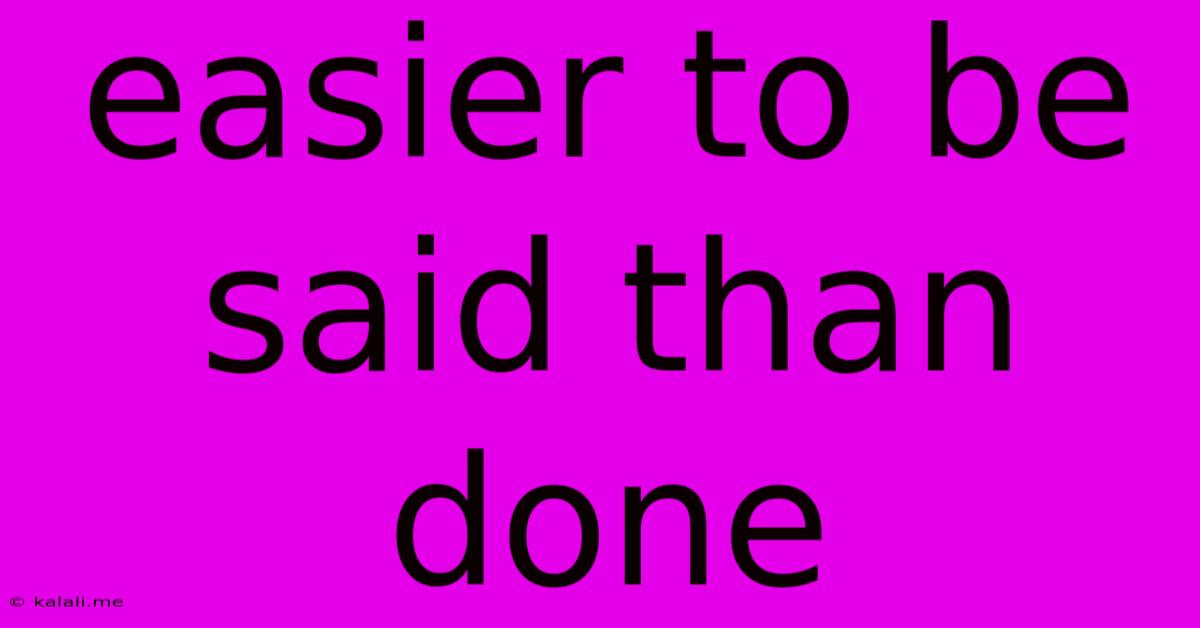Easier To Be Said Than Done
Kalali
May 25, 2025 · 3 min read

Table of Contents
Easier Said Than Done: Understanding the Gap Between Intention and Action
The phrase "easier said than done" is a common idiom, reflecting a universal human experience. We all harbor aspirations, plans, and resolutions, only to find the execution significantly more challenging than the initial conception. This article delves into the psychology behind this phenomenon, exploring the common obstacles that prevent us from translating our good intentions into concrete actions, and offering strategies to bridge the gap between aspiration and achievement.
This common experience highlights the discrepancy between intention and action, often stemming from a variety of factors. We'll explore common barriers and provide practical solutions to move from intention to action more effectively.
The Psychology of "Easier Said Than Done"
At the core of this struggle lies a disconnect between our cognitive planning and our behavioral execution. Our minds can readily envision success, outlining clear steps and anticipating positive outcomes. However, the reality of implementation often involves unforeseen obstacles, emotional setbacks, and the sheer force of inertia. This is influenced by several key psychological factors:
- Cognitive Dissonance: The discomfort of holding conflicting beliefs (e.g., wanting to achieve a goal versus lacking the motivation to work towards it) can lead to procrastination and avoidance.
- Planning Fallacy: We tend to underestimate the time, resources, and effort required to complete tasks, leading to unrealistic expectations and subsequent disappointment.
- Self-Efficacy: A strong belief in one's ability to succeed is crucial. Low self-efficacy can lead to self-doubt and a reluctance to even begin.
- Procrastination: The act of delaying or postponing tasks, often due to fear of failure, perfectionism, or simply a lack of motivation.
- Emotional Regulation: Negative emotions like fear, anxiety, or stress can significantly impair our ability to focus and act effectively.
Overcoming the Hurdle: From Intention to Action
Bridging the gap between "said" and "done" requires a conscious effort to address the psychological and practical challenges involved. Here are some strategies:
- Set Realistic Goals: Break down large, overwhelming goals into smaller, more manageable steps. This approach makes progress feel achievable and prevents feelings of being overwhelmed.
- Develop a Strong "Why": Understanding the deeper reasons behind your goals will provide intrinsic motivation to persevere through challenges.
- Build Self-Efficacy: Celebrate small victories along the way to boost confidence and reinforce the belief in your abilities. Seek out support from mentors or peers.
- Time Management Techniques: Employ methods like time blocking, the Pomodoro Technique, or Eisenhower Matrix to prioritize tasks and allocate time effectively.
- Mindfulness and Self-Compassion: Practice mindfulness to become more aware of your thoughts and emotions, and treat yourself with kindness and understanding when setbacks occur.
- Accountability: Share your goals with someone you trust who can offer support and hold you accountable for your progress.
Conclusion: The Power of Consistent Action
While the adage "easier said than done" reflects a common truth, it shouldn't be interpreted as an excuse for inaction. By understanding the underlying psychological factors and implementing practical strategies, we can significantly improve our ability to translate our intentions into tangible accomplishments. The journey from aspiration to achievement is rarely straightforward, but with consistent effort and self-awareness, we can overcome the hurdles and achieve our goals. Remember, consistent action, no matter how small, is the key to bridging the gap between what we say we'll do and what we actually do.
Latest Posts
Latest Posts
-
How Many Cups From A Pound Of Coffee
May 25, 2025
-
How To Keep Meringue From Shrinking
May 25, 2025
-
Dishwasher Filling With Water When Off
May 25, 2025
-
No Matching Key Exchange Method Found Their Offer Diffie Hellman Group14 Sha1
May 25, 2025
-
Lift That Barge Tote That Bale
May 25, 2025
Related Post
Thank you for visiting our website which covers about Easier To Be Said Than Done . We hope the information provided has been useful to you. Feel free to contact us if you have any questions or need further assistance. See you next time and don't miss to bookmark.